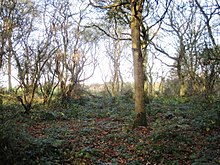페르세우스 OB1
Perseus OB1| 페르세우스 OB1 | |
|---|---|
 | |
| 관측 데이터(J2000 epoch) | |
| 별자리 | 페르세우스 |
| 우측 상승 | 02h 21m[1][2] |
| 탈위임 | +57.6°[1][2] |
| 평균 거리 | 6.0kly(1.83kpc)[3] |
| 스판 | 1,000 × 750 광년[4] |
| 방사 속도 | -43.4km[5]/s |
| 물리적 특성 | |
| 회원들 | 149[6] |
| OB 별 | ≥65[7] |
| 기타 지정 | OB1당[1] |
페르세우스 OB1은 페르세우스자리에 있는 북천반구에 있는 OB 연결이다.이중 성단(NGC 869, NGC 884)을 중심으로 하고 있으며,[6] 은하수의 페르세우스 암에 그 이름을 빌려주었다.[8]이 협회의 가장 밝은 회원은 청색 초거성 9 페르세이다.[4]
참조
- ^ a b c "Per OB1". SIMBAD. Centre de données astronomiques de Strasbourg. Retrieved 2020-01-15.
- ^ a b Sitnik, T. G. (May 2003). "The Line-of-Sight Velocities of OB Associations and Molecular Clouds in a Wide Solar Neighborhood: The Streaming Motions of Stars and Gas in the Perseus Arm". Astronomy Letters. 29: 311–320. Bibcode:2003AstL...29..311S. doi:10.1134/1.1573280.
- ^ Melnik, A. M.; Dambis, A. K. (2020). "Distance scale for high-luminosity stars in OB associations and in field with Gaia DR2. Spurious systematic motions". Astrophysics and Space Science. 365 (7). arXiv:2006.14649. doi:10.1007/s10509-020-03827-0. S2CID 220128144.
- ^ a b Crossen, Craig; Rhemann, Gerald (2012). Sky Vistas: Astronomy for Binoculars and Richest-Field Telescopes. Springer Science & Business Media. p. 93. ISBN 9783709106266.
- ^ Mel'Nik, A. M.; Dambis, A. K. (2009). "Kinematics of OB-associations and the new reduction of the Hipparcos data". Monthly Notices of the Royal Astronomical Society. 400 (1): 518. arXiv:0909.0618. Bibcode:2009MNRAS.400..518M. doi:10.1111/j.1365-2966.2009.15484.x.
- ^ a b Lee, Hsu-Tai; Lim, Jeremy (June 2008). "On the Formation of Perseus OB1 at High Galactic Latitudes". The Astrophysical Journal. 679 (2): 1352–1363. arXiv:0804.4520. Bibcode:2008ApJ...679.1352L. doi:10.1086/587801.
- ^ Beech, Martin; Slawson, Robert W. (December 1995). "Are There Really Blue Stragglers in Per OB1?". Astrophysics and Space Science. 234 (2): 217–221. Bibcode:1995Ap&SS.234..217B. doi:10.1007/BF00627667.
- ^ Inglis, Michael (2013). Observer’s Guide to Star Clusters. New York, New York: Springer Science & Business Media. p. 184. ISBN 978-1-4614-7567-5.


